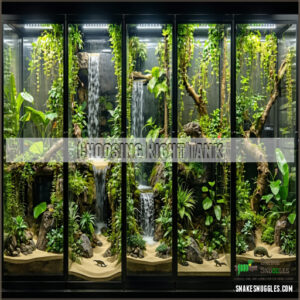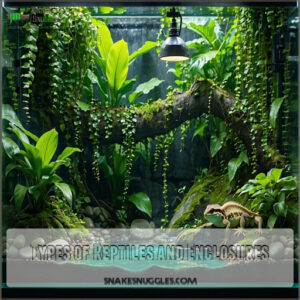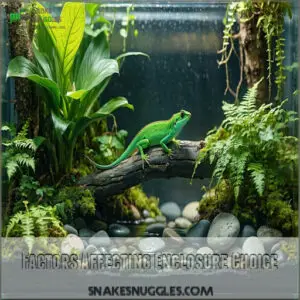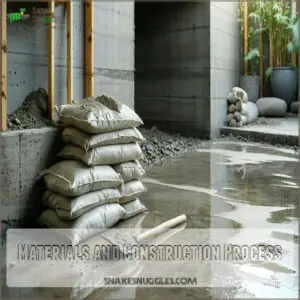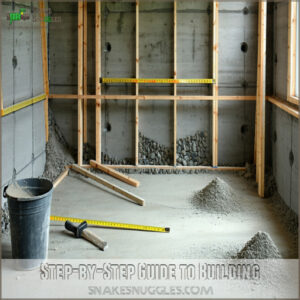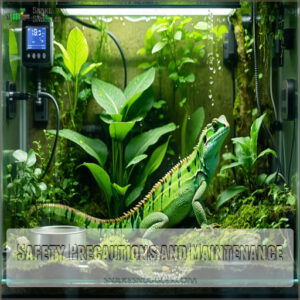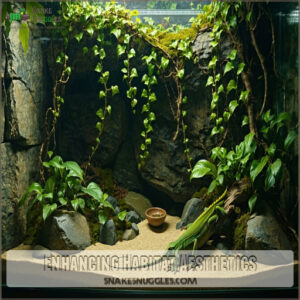This site is supported by our readers. We may earn a commission, at no cost to you, if you purchase through links.

You’ll want to match your enclosure choice to your reptile’s natural behaviors – climbers need tall spaces, while ground-dwellers prefer width.
Glass tanks offer great visibility but wooden vivariums retain heat better.
Don’t forget proper ventilation and UVB lighting – they’re absolute game-changers for your pet’s health.
The right setup isn’t just about space; it’s about creating an environment where your reptile can thrive.
Getting these fundamentals right sets the stage for more advanced habitat features that’ll truly make your setup shine.
Table Of Contents
- Key Takeaways
- Choosing Right Tank
- Enclosure Selection Tips
- Concrete Habitat Benefits
- Designing Reptile Habitats
- Building Concrete Habitats
- Enhancing Habitat Aesthetics
- Frequently Asked Questions (FAQs)
- How do I create a perfect reptile habitat?
- What makes a good reptile habitat?
- How do I choose the perfect lighting for my reptile habitat?
- How do you care for a reptile?
- What is a substrate for a reptile?
- How do you make a reptile habitat scaly?
- What 5 basic things are needed to house a reptile?
- What is the ideal enclosure for reptiles?
- What is the best habitat for reptiles?
- How to organize a reptile room?
- Conclusion
Key Takeaways
- You’ll need to match your enclosure choice to your reptile’s natural behaviors – climbers need tall spaces while ground-dwellers prefer width, and ensure the size is at least 1.5 times your pet’s length and depth.
- You must maintain proper ventilation and UVB lighting to regulate temperature and humidity levels – use ventilation panels for steady airflow and ensure appropriate lighting cycles to support your reptile’s natural behavior.
- You’ll want to select substrate and decor that mirrors your pet’s natural habitat – choose safe materials like coconut fiber or reptile sand, and add climbing structures, hiding spots, and basking areas to encourage natural movement.
- You’ve got to monitor and adjust your habitat setup regularly – check temperature gradients, clean water dishes daily, spot clean waste, and watch for signs of stress in your reptile’s behavior to ensure their continued health and well-being.
Choosing Right Tank
Picking the right tank for your reptile is all about understanding its specific needs, like space, temperature, and activity.
A well-chosen enclosure keeps your pet healthy, comfortable, and safe as it grows.
Reptile Species Requirements
Every reptile has unique habitat requirements, so research your species’ needs before setting up.
From temperature to lighting, species-specific care is essential for health and happiness.
Proper reptile habitat setup is critical for their well-being.
Simulating their natural environment, like adding branches for climbing or warmer zones for basking, encourages natural behavior.
Understanding environmental factors guarantees proper reptile species care.
Always prioritize your pet’s well-being!
Enclosure Size Considerations
Picking the right reptile enclosure size is essential for your pet’s health and happiness.
Think about your reptile’s species size, future growth, and habitat requirements. Reptile space should allow natural movement, with tank depth, habitat width, and enclosure length offering comfort.
A solid reptile tank setup guarantees balanced mobility and prevents stress, setting the foundation for a perfect reptile enclosure setup with natural movement.
Tank Material Options
When choosing reptile enclosure materials, the type matters for your pet’s comfort and health.
Glass tanks are great for visibility but lack insulation. Wooden vivariums keep heat well, while plastic terrariums are lightweight and easy to clean.
Metal cages suit climbing reptiles. Acrylic tanks offer durability and clarity.
You can find helpful resources for terrarium decor and hides. Always pick a safe material suited for your species.
Enclosure Selection Tips
Choosing the right enclosure means considering your reptile’s size, habits, and natural habitat.
Whether it’s tall for climbers or wide for ground dwellers, your enclosure should keep them comfortable and healthy.
Types of Reptiles and Enclosures
Reptile species vary widely, so their enclosures must suit their natural behaviors.
Arboreal reptiles like chameleons need tall setups for climbing, while desert reptiles thrive in spacious, horizontal habitats.
You’ll choose enclosure materials like glass or PVC wisely—they affect insulation and visibility.
Research species-specific needs to guarantee habitat security, considering lighting, ventilation, and reptile diversity for perfect reptile habitat design.
Factors Affecting Enclosure Choice
A reptile’s unique needs should steer your enclosure design.
Focus on these factors:
- Species Research: Understand your pet’s habits, size, and preferences.
- Enclosure Security: Pick a design that prevents escapes and injuries.
- Tank Placement: Avoid drafts, direct sunlight, or noisy areas.
- Habitat Safety: Use non-toxic materials and safe decor for a healthy space.
Thoughtful planning brings happy reptiles!
Importance of Ventilation and Lighting
Good air quality keeps your reptile healthy, so don’t skimp on proper ventilation systems.
Poor airflow can mess with temperature control and humidity management, stressing your pet.
Lighting matters too—UVB lighting supports growth and keeps bones strong.
Balance light cycles for natural behavior.
Together, reptile habitat ventilation and lighting shape a cozy, well-regulated environment for temperature regulation and humidity control.
Concrete Habitat Benefits
Concrete habitats are tough, reliable, and great at holding steady temperatures, which helps keep your reptile comfortable.
They also trap humidity well and can be designed to look like a natural home for your pet.
Durability and Temperature Regulation
Concrete’s strength makes it a smart choice for reptile habitats—it resists wear and handles active pets.
Plus, its thermal mass helps with temperature control, keeping things steady inside.
For better climate control, concrete’s natural insulation types support reliable temperature gradients.
Here’s why it works:
- It absorbs and releases heat efficiently.
- Withstands scratching and climbing.
- Simplifies reptile habitat design maintenance.
Concrete provides a reliable and efficient way to manage the environment of reptile habitats, making it an ideal material for reptile habitats.
Humidity Control and Naturalistic Appearance
Humidity is key for your reptile’s health.
Use mist systems or foggers for steady reptile humidity control.
Humidity gauges verify proper levels, avoiding mold or dryness.
Water features or live plants improve the naturalistic appearance while managing humidity.
Experimenting with these creates a balanced reptile habitat environment that mimics nature.
Proper snake terrarium humidity control is essential for a healthy environment, and understanding humidity control methods helps in creating an ideal setup.
| Tools | Benefits | Challenges |
|---|---|---|
| Mist Systems | Steady moisture levels | Needs regular cleaning |
| Foggers | Increases air humidity | Can cause over-humidity |
| Live Plants | Naturalistic appeal | May require extra care |
| Humidity Gauges | Precise monitoring | Requires frequent checks |
Customization Options for Reptiles
With customization, you can tailor your reptile habitat design to fit species-specific needs perfectly.
Incorporate habitat themes that mimic their natural surroundings, like rocks for desert reptiles or branches for climbers.
Reptile enrichment is key—add hides, climbing structures, or spacious basking spots.
Proper species research secures environmental control and a naturalistic appearance, fostering ideal reptile behavior.
These habitat design tips enhance any reptile environment, promoting a healthy and thriving reptile habitat with proper environmental control.
Designing Reptile Habitats
When designing a reptile habitat, you’ll need to think about size, layout, and making it feel like home for your pet.
Focus on good ventilation, proper lighting, and safe materials to create a space that keeps your reptile healthy and happy.
Size and Layout Considerations
When planning your reptile habitat design, always prioritize the right tank dimensions. Consider your reptile’s activity level and growth to decide on habitat depth and enclosure shape.
Scaling plans wisely helps avoid upgrades later. Explore different enclosure types for adaptability.
Larger spaces support natural behaviors, so aim for size over aesthetics. A thoughtful habitat layout promotes comfort and well-being, and is crucial for the reptile’s activity level.
Ventilation and Lighting Requirements
Proper ventilation and lighting are non-negotiable for your reptile’s health. Easily control airflow with ventilation systems to avoid stale air.
For healthy reptiles, consider proper snake lighting requirements. Temperature regulation and UVB lighting guarantee your pet thrives.
Check these off:
- Use reptile habitat ventilation panels for steady airflow.
- Pick light types suited to temperature control.
- Maintain humidity levels with proper lighting.
- Monitor conditions regularly for safety.
Substrate and Landscaping Features
Inside your reptile’s habitat, choosing the right substrate and landscaping features creates a cozy home that mirrors their natural environment.
You can find suitable reptile substrate mix products online. You’ll want to mix substrate types like coconut fiber or reptile sand based on your pet’s needs.
Add rock features for basking spots, and select hardy plants that can handle the humidity. Remember to place decor strategically – your scaly friend needs both hiding spots and open areas to explore.
Building Concrete Habitats
You’ll love how concrete habitats give your reptile a sturdy, natural-looking home that keeps temperature and humidity just right.
While they take more work to build than store-bought enclosures, you can customize every detail to match your pet’s needs, from built-in basking spots to perfect hiding places, allowing for a natural-looking environment.
Materials and Construction Process
Before diving into your concrete reptile habitat construction, you’ll need specific materials: high-quality concrete mix, reinforcement mesh, and tank linings.
You can find more information on concrete reptile enclosures.
Start with a sturdy habitat frame, add proper insulation types, and ensure you’re following local building codes.
When mixing concrete, aim for a smooth consistency that’s neither too wet nor too dry. The right materials make sure your reptile’s home stays strong and safe.
Step-by-Step Guide to Building
Now that you’ve gathered your materials, let’s build your dream reptile habitat! Here’s your road map to construct a safe, stunning enclosure that’ll make your scaly friend feel right at home.
Proper enclosure sizing is paramount for reptile health and well-being. Remember, each measurement and layer builds toward your perfect custom reptile home.
- Mark and measure your space twice – there’s nothing worse than a wobbly habitat
- Mix your concrete carefully – too wet means cracks, too dry means trouble
- Create texture while it’s wet – your reptile will thank you for those grip-friendly surfaces
- Install proper drainage channels
- Let it cure fully – patience pays off!
Take your time with the construction process, and follow each step carefully. Your attention to detail now means a happier, healthier habitat for years to come.
Safety Precautions and Maintenance
Now that you’ve built your concrete habitat, let’s keep it safe and spotless.
Regular cleaning schedules prevent bacteria buildup – you’ll want to disinfect water dishes daily and spot clean any waste.
Monitor your reptile’s health by watching their behavior and checking for stress signs.
Install secure locks for escape prevention, and keep a close eye on temperature and humidity levels.
Remember, a clean habitat equals a happy reptile!
Enhancing Habitat Aesthetics
You’ll want to make your reptile’s home look both beautiful and natural, just like their habitat in the wild.
With proper substrate choices and safe decorations, you can create an eye-catching display that keeps your scaly friend happy and healthy while showing off their unique personality.
Safe Decor Choices for Reptiles
The right decor transforms your reptile’s habitat from a simple enclosure into a cozy retreat.
When selecting decorations, prioritize non-toxic plants and sturdy climbing branches that won’t collapse under your pet’s weight.
Creating enriching reptile enclosure decoration tips is essential for their well-being.
Create multiple hiding places using natural rocks and cork bark, which help reduce stress.
Remember, safe decor isn’t just about looks – it’s about creating a secure, enriching environment your scaly friend will love.
Substrate Selection and Placement
Selecting the perfect substrate for your reptile’s home is like choosing the right mattress – it needs to be just right.
Consider moisture levels and humidity control when picking between options like coconut fiber, reptile carpet, or sand.
Your substrate choice affects your pet’s comfort and health, so match it to their natural habitat.
Place substrate deeper in areas where they love to dig or burrow, considering their natural habitat.
Creating Naturalistic Environments
Transform your reptile’s enclosure into a slice of their natural habitat by combining diverse textures, levels, and hiding spots.
You’ll want to mimic environmental gradients they’d encounter in the wild – think varying heights for climbing species or sandy dunes for desert dwellers.
Add natural lighting to support their daily rhythms, and include species-specific elements like cork bark or river rocks that encourage natural behaviors.
Frequently Asked Questions (FAQs)
How do I create a perfect reptile habitat?
Want to be the ultimate reptile parent?
Match your tank size to species needs, maintain proper temperature and humidity levels, add enriching decor, and create distinct basking zones for your scaly friend’s comfort.
What makes a good reptile habitat?
You’ll need proper heating, UVB lighting, and enough space for your reptile to move around.
Don’t forget hiding spots, clean substrate, and the right humidity levels – it’s like creating their perfect mini-world.
How do I choose the perfect lighting for my reptile habitat?
You’d think picking lights is rocket science, but it’s not.
Research your reptile’s UVB needs, install both heating and UVB bulbs.
Create basking spots with proper temperature gradients for their health.
How do you care for a reptile?
You’ll need to monitor temperature, provide proper lighting, feed appropriate food, maintain humidity, clean regularly, and make certain a suitable habitat size.
Don’t forget regular vet checkups for your scaly friend’s health.
What is a substrate for a reptile?
You’ll place substrate, like coconut fiber, sand, or wood chips, on the bottom of your reptile’s enclosure.
It’s the bedding material that helps maintain humidity and lets your pet dig naturally.
How do you make a reptile habitat scaly?
Ever dreamed of a dragon’s lair?
You’ll create textured paradise by adding rough bark pieces, layering different-sized rocks, and installing climbing branches.
Don’t forget slate tiles for that perfect scaly look.
What 5 basic things are needed to house a reptile?
You’ll want to include a secure enclosure that’s properly sized,
heating elements for temperature control,
UVB lighting to simulate sunlight,
and appropriate substrate for burrowing.
You’ll also want to include hiding spots where your reptile can feel safe.
What is the ideal enclosure for reptiles?
In brief, you’ll need a secure enclosure that’s 5 times your reptile’s length and depth.
Choose glass tanks for visibility, wooden vivariums for insulation, or plastic terrariums based on your pet’s specific needs, considering the complete concepts of their habitat requirements.
What is the best habitat for reptiles?
You’ll need an enclosure that matches your reptile’s size and natural habitat.
Choose between glass tanks, wooden vivariums, or plastic terrariums, and include proper heating, lighting, ventilation, and species-specific environmental features.
How to organize a reptile room?
Arrange your reptile enclosures on sturdy shelves with heat-resistant surfaces.
You’ll want to group similar species together, maintain proper ventilation, and keep feeding stations separate.
Don’t forget easy access for cleaning!
Conclusion
Just like architects design homes to match their residents’ needs, your reptile habitat design tips should focus on creating a space that feels natural and comfortable for your scaly friend.
Remember to choose the right enclosure size, maintain proper lighting and ventilation, and select appropriate substrates and decorations.
With careful planning and attention to detail, you’ll create a perfect home where your reptile can thrive. Keep monitoring and adjusting the habitat as needed – your pet’s wellbeing is worth the effort.
- https://reptilesupershow.com/essential-reptile-habitat-setup-guide-tips/
- https://talis-us.com/blogs/news/the-ultimate-guide-to-creating-a-reptile-habitat
- https://myhealthyreptile.com/how-to-build-a-diy-reptile-enclosure/
- https://allanspetcenter.com/creating-a-naturalistic-lizard-habitat-unleashing-the-wild-beauty-in-your-reptiles-home/
- https://www.zillarules.com/articles/how-to-set-up-a-reptile-tank

